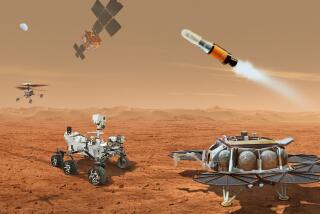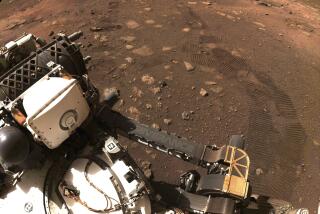Face to Face With the Future
- Share via
Are we alone? We have explored every corner of this planet and most of the solar system in our attempts to find an answer to this question. Do we now have it?
In the 18th and 19th centuries, telescopic observations of the seasonal variations on Mars led “everyone” to believe that life existed there. Percival Lowell published detailed descriptions of ancient Martian civilizations fighting drought by building canals from the poles to the equator. This belief in life on Mars was so widely held that a 100,000-French-franc award was offered for communication with any planet other than Mars. Our perceptions were shaped by Orson Welles’ radio production of H.G. Wells’ “War of the Worlds” in 1938 and by a series of fantasy-adventure novels by Edgar Rice Burroughs.
Twenty years ago, the Viking landers touched down on the surface of Mars. The project’s investigators studied samples of the Martian soil and concluded that they had found no evidence of life or organic carbon, that liquid water could not persist on the surface and that the intense solar radiation, unfiltered by the air, would probably destroy both life and any organic residue of life on the Martian surface. The consensus of scientists has become that life might have existed on early Mars when the climate was more suitable, but evidence of life would have to be found by careful search in selected places believed to have had favorable ancient environments. To that end, NASA is conducting a series of missions over the next 10 years, starting with launches this fall. These missions will address questions of climate history, resources, environments that might contain evidence of life and, in particular, the complex role of water on Mars, since this is a key to all other questions.
This week, a group of NASA and university scientists described their meticulous investigations using instruments that are only now becoming available, as they followed clues in a complex and exciting detective story. Here it is:
About 4.5 billion years ago, molten material below the surface of Mars crystallized into rocks much like some found on Earth. Over time, this rock became the exposed surface of Mars as meteorites blasted away the overlying layers of rock. Later on--about 3.6 billion years ago, a time when it is generally thought that the planet was warmer and wetter--liquid water penetrated fractures in the rock and deposited calcium carbonate there, assisted by microscopic organisms. Some of these organisms became trapped in the calcium carbonate. Then, some 16 million years ago, a large comet or asteroid struck Mars, ejecting a piece of this rock with enough force for it to escape the planet’s gravity. After drifting in space for millions of years, the chunk of rock encountered the Earth’s atmosphere 13,000 years ago and fell in Antarctica as a meteorite. Collected in 1984, it has been in storage until the inception of this very detailed study about two years ago. The details in this history illustrate the power of modern analytical techniques and the scientific skills of the team.
No Hollywood producer would buy this story of how an ancient 4.2-pound, potato-sized rock became the subject of a national press conference.
Scientists have pronounced themselves “skeptical but thrilled,” “skeptical but fascinated,” “skeptical but optimistic.” The scientific team carefully laid out their data and reasoning. Its members agreed that almost every piece of evidence could be explained in other ways, but that the most reasonable interpretation of all the evidence is that primitive life was present on early Mars. The team presented a very compelling case, one that opens a new door of inquiry. Intense scientific debate will ensue, the evidence will be carefully scrutinized and all of the known Martian meteorites will become the subject of even more intense study. This rock, however, provides no evidence as to whether life now exists on Mars.
As the project scientist for the Mars Global Surveyor mission to be launched from Cape Canaveral Nov. 6, I must ask myself how this discovery affects our objectives. We plan to map the distribution of rocks and ice and determine their compositions, monitor global weather and study how the atmosphere interacts with the surface. This will tell us where future missions should land to explore in more detail and perhaps bring back samples to Earth. This new information will make the search for carbonate-bearing environments more important. In the long run, however, scientific scrutiny and debate of the discovery may accelerate future mission plans.
As a human being and as a scientist, I must also ask how this discovery affects me. I understand and accept the evidence, but I’m not certain that I believe it. Did life originate independently on another planet? Is life unique? Did life originate on another planet and migrate to Earth? Is there life on many planets? Is it like that on Earth? It may be that all of us will have to confront the answers to these questions in our lifetimes and that we are facing one of the great turning points of human history.






